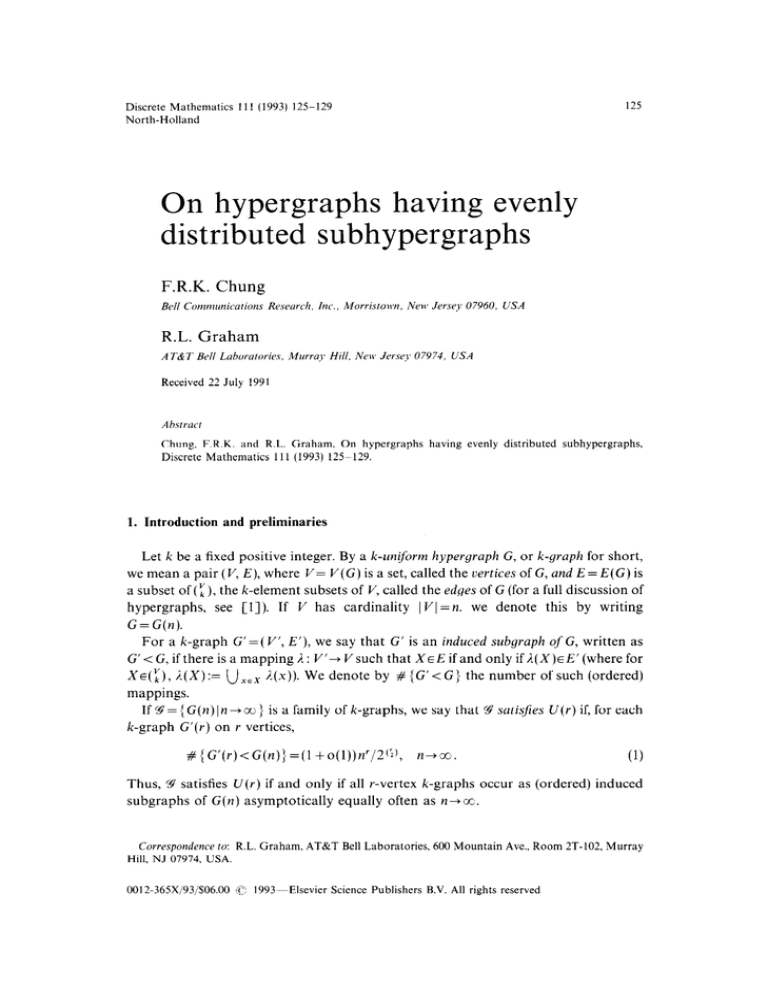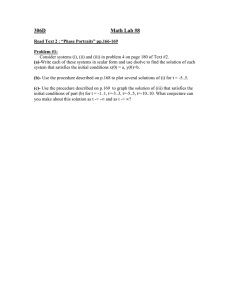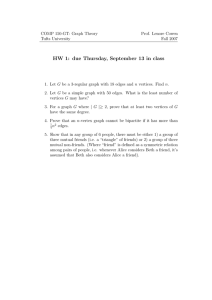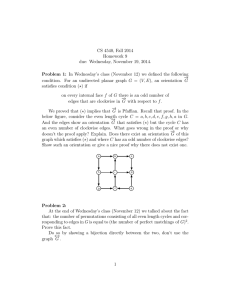
Discrete Mathematics
North-Holland
125
111 (1993) 125-129
On hypergraphs having evenly
distributed subhypergraphs
F.R.K. Chung
Bell Comnumications
Research,
Inc., Morristown,
Nebv Jersey 07960, USA
R.L. Graham
A T&T Bell Laboratories,
Received
Murra.)~ Hill, New Jersey 07974, USA
22 July 1991
Abstract
Chung, F.R.K. and R.L. Graham,
On hypergraphs
Discrete Mathematics
111 (1993) 125-129.
having
evenly
distributed
subhypergraphs,
1. Introduction and preliminaries
Let k be a fixed positive integer. By a k-uniform kypergrapk G, or k-graph for short,
we mean a pair (V, E), where V= V(G) is a set, called the vertices of G, and E = E(G) is
a subset of (I), the k-element subsets of V, called the edges of G (for a full discussion of
hypergraphs,
see Cl]). If V has cardinality
IV1 =n. we denote this by writing
G=G(n).
For a k-graph G’=( V’, E’), we say that G’ is an induced s&graph ofG, written as
G’< G, if there is a mapping 1: V’+ V such that XEE if and only if I(X)EE’ (where for
X4,
j4X):= ux.x 3.(x)). We denote by # {G’< G} the number of such (ordered)
mappings.
If ‘3 = {G(n) 1n + CC} is a family of k-graphs, we say that 3 satisfies U(r) if, for each
k-graph G’(r) on r vertices,
#{G’(r)<G(n)}=(l+o(l))n’/2(~),
n+cc.
(1)
Thus, 9 satisfies U(r) if and only if all r-vertex k-graphs occur as (ordered)
subgraphs of G(n) asymptotically
equally often as n--tm.
Correspondence to: R.L. Graham,
Hill, NJ 07974, USA.
0012-365X/93/$06.00
lc
AT&T Bell Laboratories,
1993-Elsevier
Science Publishers
600 Mountain
induced
Ave., Room 2T-102, Murray
B.V. All rights reserved
126
F.R.K. Chung, R.L. Graham
In particular, if each G(n) is a random k-graph G,,,(n)=(
V(n),E(n))
on IZvertices,
i.e., each XE( Vr) ) is chosen as an edge of G1,2(~) independently
with probability
l/2,
then the corresponding
family 91/z almost certainly satisfies U(r) for any fixed Y(i.e.,
satisfies U(r) with probability
tending to 1 as n+a3).
It is not difficult to see that if 99 satisfies U(r) then $59also satisfies U(s) for any s d r.
On the other
implication
hand,
it is perhaps
unexpected
that
once s is as large as 2k. More precisely,
U(2k)
If 9 satisfies
then $9 satisfies
it is possible
to reverse
this
it was shown in [2] that:
U(r) for any fixed r.
(2)
Families 9 satisfying (2) have been termed quasi-random,
since it is known that they
must necessarily also satisfy a large collection of other properties all shared by families
of random k-graphs (for details, see [2-41).
However, it was noted in [2] that (2) is no longer valid if U(2k) is replaced by
U(k+ 1). The main purpose of this note is to close this gap completely, by showing
that (2) no longer holds even if we assume 9 satisfies U(2k- 1). More generally, for
each s, with kds62k1, there are families gS which satisfy U(s) but not U(s+ 1).
A less direct proof for this construction
appears in [3].
2. The main construction
If G=( V, E) is a k-graph,
X=XG:
+
k”
we let
{0, 1j be the edge function
for G,
0
defined for XE(:)
x(X)=
by
1
if XEE,
0
if X&E.
For a 20, we define the coboundary
operator a(‘) mapping k-graphs on V to (k+a)graphs on V as follows. If G =( V, E) is a k-graph with edge function
x, then
6(“)G=( V, Et”)) is a (k+a)-graph
with edge function x@), given, for YE( kya), by
$“‘(Y)=
c
x(X) (mod2).
XSC)
(3)
Thus, Y is an edge of 6(“)G if and only if Y contains an odd number of edges X of
G as subsets.
For 1 < j d k - 1, choose a random j-graph G$ on I/ and ‘lift’ it to a k-graph
G.:=GCk-j) G$ on V with edge function Xj. Next, form the ‘symmetric difference’
k-graph G*(n)=( V, ~*(n))=Vjk~: Gj with edge function x*, defined by
k-l
x*(X)=x
xj(X)
j=
1
(mod2)
for XE
:
0
.
Hypergraphs
Theorem 2.1. For almost all choices ofG$,
but not U(2k), provided k#2’, ta0.
Proof. Consider
Form
an arbitrary
a matrix
127
hauing evenly distributed subhypergraphs
3* = { G*(n)ln+a}
satisfies
U(2k-
1)
fixed set W= { w1, w2,. . . , wzk- 1 } of 2k - 1 vertices of I’.
M with rows indexed
by XE(~),
and columns
indexed
by Yj~(y),
1 d j< k - 1, with the (X, Yj)-entry M(X, Yj) defined to be 1 if YjC X, and 0 otherwise.
We can regard each column C( Yj) of M as a function mapping (I) to (0, l} by
defining
C(Yj)(X)=M(X,Yj),
XE
.
It is easy to see that
xj=
C
C(Yj)(mod2).
YjSfW) i
so
that
k-l
X*E
C
j=
1
1
C( Yj)(mod2).
~~~(7)
We now apply a result of Wilson [6] (see also [S]) which asserts that, when k#2’,
M has mod 2 rank equal to ( 2k; ’ ). Actually, Wilson’s result implies that if we adjoin
a column of all l’s to form an augmented matrix M ‘, then for any prime p, M + has
mod p rank equal to ( 2k; ’ ). H owever, when k # 2’, then some i, with 1 d id k - 1, has
(F) odd. Summing all the columns C( Yi), YiE( r), gives US a column of all l’s (mod 2),
from which it follows that M itself has mod 2 rank equal to ( 2k; ‘).
Now, as W ranges over all (2k- I)-element subsets of V, since the edges of the
various corresponding
G$ are chosen independently
and uniformly, then an easy
argument shows that almost certainly each of the possible ( 2k; ‘) (0, I)-vectors occurs
(1 +o(l))n2k-1/2(2X;‘)
times as it-+ cc. But this just means that for almost all choices of
the G:j,\, each of the possible
k-graphs
G(2k- 1) on 2k- 1 vertices occurs
(1 +o(l))n2k-1/2’zX3
times as an induced subgraph of G*(n) as n+ co. This implies
that 3* satisfies U(2kTo show that
3*
l), as claimed.
does not satisfy
U(2k), we do the following.
Let
zk(O), i&(I)} be an arbitrary 2k-element subset of I’. Consider the
Z=fz,(O),z,(l),...,
inclusion matrix M with rows indexed by XE(~), and columns indexed by YjE(:),
1 d j d k - 1. Let us restrict our attention to the 2k rows indexed by all the k-sets of the
form Z(al ,...,&k)={Z1(&1),...,
zk(&k)},
where EiE{O, l}, 1 <i<k.
For a fixed Yj~(~),
since j< k- 1, there must exist at least one index i such that Zip
Yj, Zip
Yj. Thus,
ak)xYjifand
only if Z(s, ,..., ~~_~,l,c~+i ,..., aL)zYj. This
Z(a 1,...,&i-1,O,&i+l,...,
implies that for any column of M, the total number of l’s in the 2k rows indexed by
the Z(cl,. . . , &k) is always even. Hence, this also holds for the mod 2 sum of any set of
columns of fi. Consequently,
9* contains no indexed subgraph on a 2k-set Z in which
an odd number of k-sets Z(E~,
, &k) are edges. This shows that 9* does not satisfy
U(2k), and Theorem 2.1 is proved.
i?
128
F.R.K.
Chung, R.L. Graham
In the case that k=2’, an additional step is required. As before, we first construct
the k-graphs G*(n)=(V,,,E).
We then take the complement
G*(n)=(Vi,E’)
on
a disjoint vertex set V,‘, and form the k-graph G(2n) := (V,, u Vi, i) by defining E^to be
Eu E’, together
with a random
selection
of all the k-sets X which intersect
E’. That is, each such X is chosen independently
with probability
both E and
l/2 to be an edge
of G(2n).
Theorem 2.2. For almost all choices
but not U(2k).
of G (&,C@={G^(2n)In--+co$
satisjies
U(2k-1)
Proof. The case not covered by Theorem 2.1 is when k = 2’, which we now assume. By
the previously mentioned result of Wilson, if G(2k- 1) is a k-graph on 2k- 1 vertices
then
#{G(2k-l)<G*(n)}
=i
2(1 +o(l))nzk-‘/2(zXL1)
if G(2k-
1) has an even number
0
if G(2k-
1) has an odd number
of edges,
of edges.
Since ( 2ki ’ ) is odd for k = 2’, the situation is reversed for the complement
G*(n). This
implies that 3* satisfies U(2k- 1).
To see that 3* does not satisfy U(2k), consider the k-graph H=H((2kl)*) formed
from disjoint copies of Hi(2k- l)=( Wi, Ei), 1 < i<2k1, where each Hi(2k- 1) is
a complete k-graph on 2k - 1 vertices, i.e., 1Wi I= 2k - 1 and E = (Ii). We claim:
#{H<G(2n)}=O
for all II.
(4)
To see this, suppose the contrary. Note that we must have Wi $ V, for 1 <i< 2k - 1,
since otherwise Hi(2k- l)< G*(n), which is impossible, because each Hi(2k- 1) has
1.
an odd number (2k;1 ) of edges. Thus, for each i there is some WiE Vi, 1 <i<2kHowever, the k-graph induced by the vertex set { wi,. . . , wZk_ 1} has no edges, which
contradicts the fact that G*(n) only has induced subgraphs on 2k- 1 vertices having
an odd number of edges. This proves (4). Finally, by (2) this implies that $ does not
0
satisfy U(2k), and the proof is complete.
We remark that essentially the same arguments
can be applied for any s with
k <s d 2k - 1, i.e., showing that families gS exist satisfy U(s) but not U(s + 1). We omit
the details.
3. Concluding remarks
It would be interesting
to know whether, in fact, the cases k=2’ are inherently
different, or whether this is simply an artifact of the approach we have taken. For
Hypergraphs
having evenly distributed subhypergraphs
129
example,
we do not know, for any k=2’,
whether
there exists a family
9= {G(n)ln+m}
of k-graphs satisfying U(2k- 1) but for which, for some H(2k),
#{H(2k)<G(n)}=O
for all n.
References
[l] C. Berge, Hypergraphs
(North-Holland,
Amsterdam,
1989).
[Z] F.R.K. Chung and R.L. Graham, Quasi-random
hypergraphs,
Random Structures and Algorithms
l(l990)
105-124.
[3] F.R.K. Chung and R.L. Graham, Quasi-random
set systems, J. Amer. Math. Sot. 4 (1991) 151-196.
[4] F.R.K. Chung, R.L. Graham
and R.M. Wilson, Quasi-random
graphs, Combinatorics
9 (1989)
3455362.
[5] P. Frank], Intersection
theorems and mod p rank of inclusion matrices, J. Combin. Theory Ser. A 54
(1990) 85594.
[6] R.M. Wilson, A diagonal form for the incidence matrices of r-subsets vs. k-subsets, European
J.
Combin. I1 (1990) 609-615.






